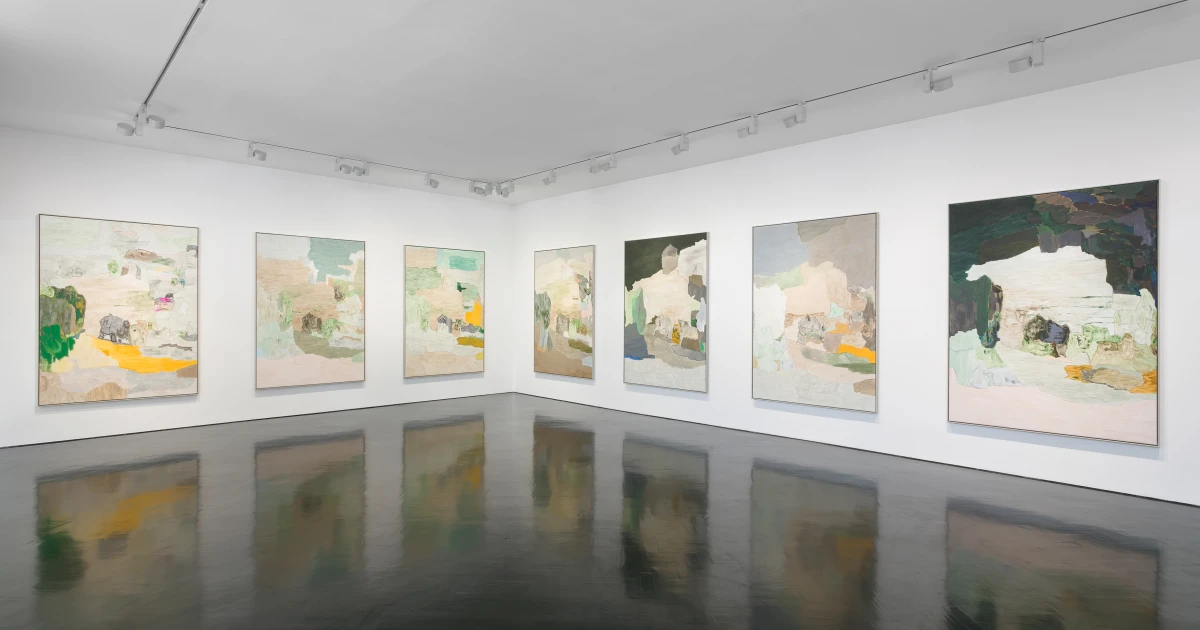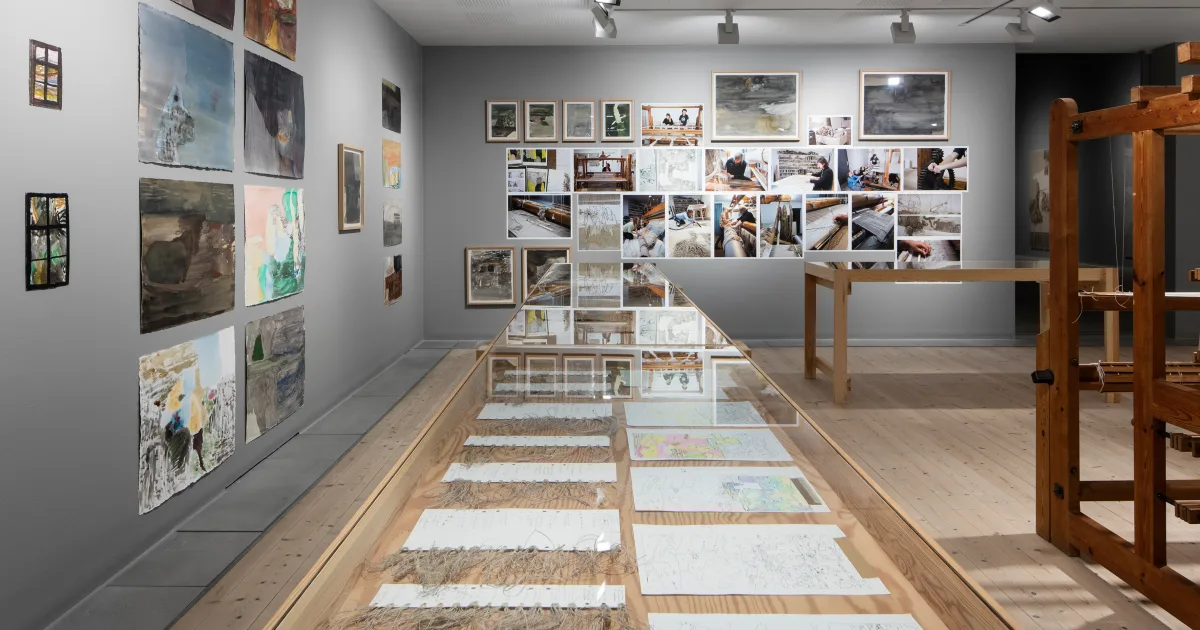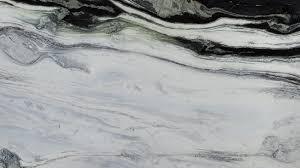Weissensee No. 12, 2018-2019
Andreas Eriksson

Hovering between abstraction and figuration, Andreas Eriksson’s meditative works can be interpreted as patchwork topographies or details of organic forms such as trees, earth and rock formations.
Eriksson’s artistic practice encompasses a wide range of media including painting, photography, sculpture, tapestry and installation. Rendered in earthy and botanical hues, his works are understated yet possess a poetic quality which has a lasting effect on the viewer. The emotional intensity of Eriksson’s work is the result of a sustained exploration of his response to the natural world.

Weissensee No. 12, 2018-2019
Linen
94 1/2 × 55 1/2 in | 240 × 141 cm
‘Weissensee No. 12’ is part of a recent series of large-scale handwoven tapestries by Andreas Eriksson. Rendered in subtle hues of undyed yarn, this body of work offers a unique window onto the artist's rural surroundings in Medelplana, Sweden. Eriksson sources the tapestries' linen from multiple sites in Sweden, linking each piece to a specific geographical location. Hovering between abstraction and figuration, this meditative work can be interpreted as a patchwork topography or a detail of an organic form. Tassels and loose threads hang freely from the surface, conjuring up associations with cascading waterfalls, patches of lichen and trees rustling in the wind. Variations in tone and structure between different types of yarn create striking modulations of light and depth, lending the work a painterly quality.
This new body of textiles expands the artist's formal language and demonstrates how he translates his paintings into tapestries

"It is impossible to trace any topography, scenery or perspective in Eriksson’s [works]. They have a strong hallucinatory power in that their lack of north- or southward orientation produces a disjunction, making it hard to understand where the sky and the ground lie."
– Filipa Ramos

Andreas ErikssonWeissensee No. 19, 2019
Linen
222 x 140cm (87 3/8 x 55 1/8in)

More Posts from Skipieohhhhh and Others
Marbling
The quality of a surface that has streaks of color, like marble

The patterns are formed by first floating the colors on the surface of a liquid, and then laying the paper or fabric onto the colors to absorb them.
looking through ancient volumes full of arcane recipes for mixing such exotic ingredients as Irish moss seaweed, spirits of green soap, and distilled bile from the gall bladder of an ox.
They were used for decorative purposes, and also as a background for official documents and signatures, to prevent erasure and forgery.
The traditional marbling inks were just not durable enough to stand up to washing. Now, though, fine marbling can be done just as easily on cloth as on paper with these new paints, and modern colors are much more vivid and brilliant and long-lasting than ever in the past.
Stone Marble: Gives the effect of real marble. Stone marbles are the simplest patterns, but they often take longer to make than the more complex combed patterns, because so many thousands of tiny droplets of color must be applied.

Marble
Marble is metamorphosed limestone, quartzite is metamorphosed sandstone, and gneiss, another common metamorphic rock, sometimes begins as granite.


Metamorphic rocks are sedimentary or igneous rocks that have been transformed by pressure, heat, or the intrusion of fluids. The heat may come from nearby magma or hot water intruding via hot springs. It can also come from subduction, when tectonic forces draw rocks deep beneath the Earth's surface.

Gerhard Richter, Clouds, 1978
Emma Larsson
https://www.instagram.com/zebrakadebra/?hl=en


Emma Larsson (a.k.a. @zebrakadebra) is a Stockholm-based artist and illustrator. Her work strikes the balance between colorful dreamscape and inarticulable melancholy. Emma has evolved her practice to include expressive and organic watercolors, alongside paintings created with oil and acrylic. She describes her work as an ongoing exploration without rules and conventions, continually generating new forms, patterns and themes. Emma has collaborated with brands and agencies including Rachel Comey, Show Studio, and Winsor & Newton.
Swedish artist Emma Larsson known for her poetic, playful, and contemplative illustrations.

Eccentric Abstraction II - Framed, 2024
Watercolor and Mixed Media on Paper
Larsson’s work is characterized by a synergy between her, the materials, and an unknown presence she calls “force.





Even though she went to art school for a few years, between drawing, painting, and sculpting, she considers herself self-taught, an outsider, experimenting with all kinds of materials. She is a creative explorer. Her work is in constant flow. It can be described as poetic, playful, contemplative, intuitive and intriguing.
The creation comes from a flow of energy, memories of nature, and freedom Emma’s paintings are purely instinctive, they source from pleasure and freedom

The result is somewhat uncanny; abstract images which feel familiar and yet strangely unknowable, perhaps like beasts from the outer reaches of space, magnified microscopic fungi, or a not-quite-discernible dream motif. They are deeply appealing in a way that is hard to articulate. You work with watercolours, acrylics, inks and oils. What is it about mixing up these mediums that creates the effects you like? For me, the paper I use is as important as the paints; its structure, thickness and ability to absorb liquids all matter a lot to me. Every piece has several layers, as I add different paint after each drying session until it feels finished. Each painting takes a couple of days to complete but I always work on a set of multiple paintings simultaneously.
"I would describe my works as intuitive expressions. I rarely have a set idea when I start the process, so the outcome is always a result of experimenting."
On your Instagram, you say that you believe that there is “No beauty without strangeness”. Can you tell us a bit more about this? Beauty is important, but it is subjective. For something to be beautiful, it doesn’t have to be pretty. Personally, I’m not drawn to the “obvious beauty” we’re told to admire in the pages of fancy magazines. There has to be some flaw for me to feel interested; it’s the imperfection or the awkwardness that attracts me.

Her use of watercolor is quite the sight to behold as she expertly fuses colors together that seamlessly bleed into a delectable kind of complexion. The tints of color come together and meld into an organic melange that ebbs to the flow of the water utilized.
the use of symmetry
Larsson’s paintings incorporate this design element in most of her works but one can see there is a deliberate imperfection when mirroring the two sides of the painting.
Drawing inspiration from nature, one can notice some familiar forms such as flowers and birds.
Hughie O'Donoghue
Born in Manchester, Hughie O’Donoghue now lives and works in rural Ireland. O’Donoghue has internationally since 1982 and is considered one of the leading painters of his generation. His work is represented in public collections, including the National Gallery, London, the Whitworth Art Gallery, Manchester and the Arts Council of England. The solo exhibition ‘Hughie O’Donoghue: Recent Paintings and Selected Works from the American Ireland Fund Donation’ was held at IMMA in 2009

Laocoon, 2003
Medium: Oil on linen canvas in 3 panels
Dimensions: Unframed, 305 x 468 cm
O’Donoghue uses figuration and abstraction to explore themes of human identity, memory, and experience; and draws on history, mythology, and personal records to create works that resonate with emotional intensity.

Fallen Elm (Kilfane) Oil on board, 71 x 122cm (28 x 48") Signed, inscribed and dated 2007/'8 verso

Evening Kilfane, Co. Kilkenny Oil on canvas, 68 x 104cm (26¾ x 41") Signed; signed inscribed and dated 2007 verso
His work is abstract in style, presenting the human body as distorted and blurred forms, drawn in thick and heavy brushstrokes. He often applies numerous layers of paint, or includes photographs or documentary sources within the canvas, covered in more paint.
The surfaces of his canvas are full of texture, in which the material takes paramount importance
This process of layering reflects O'Donoghue's interest in engaging with historical narratives, often personal in nature, so that he can express the serial form of experience and memory.

"painting is archaeology in reverse"
“The colours in my paintings are also intense, but in my work there’s never only one reason for why something is the way it is. I suppose I deliberately court the intensity of colour to mirror the intensity of feeling that comes with memory.

fascinated by the passing of time
For him, painting is a form of both archaeology and remembrance

Alice Baber (American, 1928-1982), The Light Inside the Mountain, 1978. Oil on canvas, 32 7/8 x 55 in.



ASCII-Sarah


For over forty years, Bernard Frize has examined what it means to make a painting. Working in series, he has developed diverse protocols in order to undermine his own creative role and thus free his compositions of self-expression. For Frize, paint, resin, brush and canvas are not materials to be mastered, but collaborators with whom he enters into a working relationship. The terms of this partnership may vary from series to series, but ever-constant is the notion that the media itself is equally as important as the hand of the artist in determining the look and feel of a final painting. Subtle in some works and significant in others, the drips, pools, swirls, and blobs of paint found throughout Frize’s large colorful abstractions evidence his anti-auteur relationship to painting. Preferring to raise questions rather than provide answers, Frize invites viewers to consider the implications of process and materials (what is painting) on form and content (what is a painting).

OMENA, 2023
Acrylic and resin on canvas
150 x 130 cm | 59 1/16 x 51 3/16 inch
Unique
Bernard Frize’s paintings are neither narrative nor mutilated, but they owe their creation, in large part, to a kind of sanctioned degeneration. Unruly paint has been allowed to bleed over the artist’s own brushwork, complicating systematic strokes with smudges, swathes and stains whose amorphous hazy forms that suggest various celestial bodies. Managing to appear simultaneously vibrant and on the brink of ruin, the canvas reflects Frize’s complex and ever-evolving relationship to paint, the act of painting and what it means to be a painter.


Experiment Excerpts series
Black, 2012. C-print, 60 x 50"
This series results from Nelson’s experiments with historical mordançage techniques. The patterns resembling organic matter are the outcomes ofstrong chemical reactions orchestrated in the laboratory. When combined, the molecular structures of these varying substances are dismantled and rearranged to form patterns of undulating wave-like swirls. In digitally blowing up the traces of these analog procedures, Nelson directs our attention towards the life-like features of chemicals pointing to what the writer and biochemist Isaac Asimov refers to as possibility of other worldly “life-not-as-we-know-it.” As such, Experiment Excerpts bring to mind what the feminist philosopher Jane Bennett calls “vibrant matter,” the forces and flows of materialities that can become lively, signaling, and affective; a liveliness that is swerving, buzzing, and turbulent
Brittany Nelson (b. 1984, Great Falls, MT) explores 19th-century photographic chemistry techniques and science fiction to address themes of loneliness, isolation, and distance within the queer community and its parallels with space exploration.
Mordançage Series
Distorting processes from photographic history, the vibrant patterns in these reliefs are caused by violent chemical reactions. In applying mordançage solutions to silver gelatin prints, Nelson bleaches selected areas and simultaneously lifts specific dark hues of the emulsion. This late 19th century technique is commonly appreciated for its stark contrasts, precise contours, and depths of light applied to create life-like portraits. In appropriating the historical process, Nelson suspends virtuosity and representation as photographic ideals. The works gouge a different potential application of the chemical bonds and—in continuation of feminist and queer abstraction—unfetter the constraints of resemblance to real-world referents. They call to mind Luciana Parisi’s cyberfeminist theory of microfeminine particle-forces emerging from non-linear reactions between potential and actual desires, resulting in intensifications of mutant desires.


Exhibition

23rd of October





They have a private collection upstairs, They also have on going o'Malley collection that is on show.
Ciara Roche, The 'honeymoon' exhibition
12th oct- 1st Dec
This exhibition takes place in there largest area, the main gallery.
Butler Gallery is very pleased to present an exhibition of new paintings by Wexford-born artist Ciara Roche. This is the artist’s first large-scale museum exhibition in Ireland.
This suite of paintings on canvas and paper refer to domestic scenes and public places with source imagery derived from the artist’s own photography, film stills and found imagery. Roche continues to explore representational image-making using wet and quickly applied oil paint to create a sense of luminosity and movement on the surface. The paintings explore places and themes that range from exclusive anonymous hotels to empty 24-hour cafés.
For this exhibition, Roche has embraced new challenges and created her largest paintings to date. The process, she says, was akin to learning a new language. The paintings were realised by translating her smaller sketchbook sized works onto a substantially larger framework. Figuring out materials and brushes that worked well for this new format took a while to master but the resultant paintings have been achieved with great skill and an acute awareness on how far to push things.
The Late Lounge, Roche’s largest painting to date, is both an interior and a window out to a city scape. We are invited to step into a high end restaurant, or perhaps it is a bar, complete with grand piano, and insulated against what might be happening in a corporate blue city beyond. Glass Table, like many of the paintings on view, presents more questions than answers: who sits here and what schemes are conjured up around this glass table? People are purposely missing from these paintings; the viewer is encouraged to insert themselves into the scene and create their own narrative.
There is frequently an unease in Roche’s paintings, a sort of critique of this hugely capitalistic world we live in. She is often struck by the dark side of scenarios and says that her solution is ‘to paint those fears, acknowledging the things that might happen, like exploring different versions of my life’. Viewing the works in this exhibition is like entering an uncanny world of suspense made up of light and shadow. These lushly rendered paintings, either small or large, capture timeless moments for the viewer to ponder. The rewards are wonderful.
curated by: Claire Keegan
"I don't paint people into my paintings because if I were to put a figure in them, then it would feel like the viewers couldn't go in and imagine themselves in that space... I like the idea of being able to let your mind wander and fill in the empty spaces".



* * *
“I’d rather risk an ugly surprise than rely on things I know I can do.”
- Helen Frankenthaler.